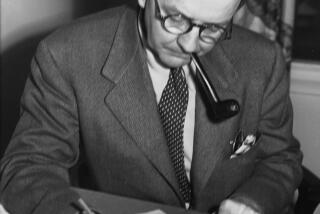Du Tu Le, beloved Vietnamese poet who came to U.S. as a refugee, dies
Du Tu Le, a towering literary figure in Vietnam and in the cities and towns across America where the waves of Vietnamese refugees and immigrants settled after the fall of Saigon, has died at his home in Garden Grove, leaving behind 77 volumes of poetry — one for each year of his life.
Though he grew up in what then was North Vietnam, he was best associated with the south, which eventually fell to communist forces at the end of the Vietnam War in 1975. Le wrote searingly of love and loss, of loyalty and separation, of longing and, ultimately, death — alternating rhythm, syntax and sensibility.
Born Le Cu Phach on Nov. 10, 1942, in Ha Nam, a province in northern Vietnam, Le started writing poetry early — in 1954, the year his parents moved the family to the south after the signing of the Geneva Accords and his homeland was split into two countries.
In Hanoi in 1958, he began using the pen name Du Tu Le in work printed in Mai magazine.
Le, who also trained as a journalist and took up art later in life, had suffered from colon cancer, but the disease had been in remission for years. His wife, Tuyen Phan, said he died in his sleep Oct. 7 after telling her he was feeling tired. He had just returned from dinner at Song Long, a favorite French Vietnamese restaurant in Orange County’s Little Saigon.
“He was a being who lived intensely, who created intensely, who put his strength and vulnerability into his work, into family and community,” Phan said. “Our lives are deeper, more meaningful having spent it with him, in his aura.”
Fellow poet Nguyen Dang Khoa said he considers Le to be among the finest Vietnamese poets, whose work spanned the upheaval when the country was torn in half and then changed forever by the war.
Le attended college in Saigon. In 1969 he traveled to Indiana to join a journalism class and later served as an editor for Tien Phong, a monthly magazine.
He published in domestic and foreign journals and his verse appeared in both the Los Angeles Times and the New York Times. Khoa said Le diligently focused on updating his work as well as that of other Vietnamese writers. He lectured at Harvard University and for many years made regular appearances at UCLA and Cal State Fullerton.
In 1993, author Neil L. Jaimeson included Le’s poetry in “Understanding Vietnam,” a literary textbook. Le is one of six 20th century Vietnamese poets whose work was selected for the anthology “World Poetry from Ancient Times to Today.”
“He loved interacting with everyone, since he wanted everyone to understand the beauty of poetry,” said Orchid Lam Quynh, his daughter.
Le met Phan when she was a college sophomore. Their romance carried a certain fascination with those in Vietnam’s literary circles, in part because she met him only after sending him a letter dismissing one of his poems as “terrible.” Intrigued, he wrote back, asking what she did for a living.
They began a correspondence that led Le to fly to Hue in central Vietnam, rent a Jeep and scour the college campus in search of his opinionated pen pal. They met, though she cut off contact after learning that he was married. She went on to become a teacher and got married herself. When both of their unions ended, they reunited and married.
Le arrived in the U.S. in 1975, in the first wave of refugees who made their way to America. In his poetry, Le reminisced frequently about his homeland.
Until the end of his life, his wife served as his editor.
“I was always the first to read anything he wrote,” she said. “If it was bad, I told him right away it was bad. I was always direct, no matter if it was his smoking or not eating healthy. He always said: ‘I am sorry, so sorry, Tuyen. I will try to do better.’ How I miss him every hour of the day.”
Le’s death resonated in Little Saigon, where Steve Dao, a graphic artist from the San Gabriel Valley, was among those who visited the neighborhood’s bookstores to pore over Le’s poetry.
“It’s amazing that he lived such a full life and that when he wrote about the cycles in life, we can so easily relate to it,” Dao said. “I am picking up new Vietnamese vocabulary now.”
Bao Bui, a grandmother from Santa Ana, said she owns more than 10 of Le’s books, some of them autographed. “Where truth and art meet, that’s where his work comes alive,” she added. “His word choices can be simple. But you don’t need to say things and be fancy to leave a lasting image.”
Some of Le’s best known work touches on unspeakable grief.
“Please bring me to the sea when I die
The upstream water will push my body away
That’s my country on the other side of the sea
The old bamboo range is forever green ...”
Le is survived by his wife, eight children and nine grandchildren.
More to Read
Start your day right
Sign up for Essential California for news, features and recommendations from the L.A. Times and beyond in your inbox six days a week.
You may occasionally receive promotional content from the Los Angeles Times.







